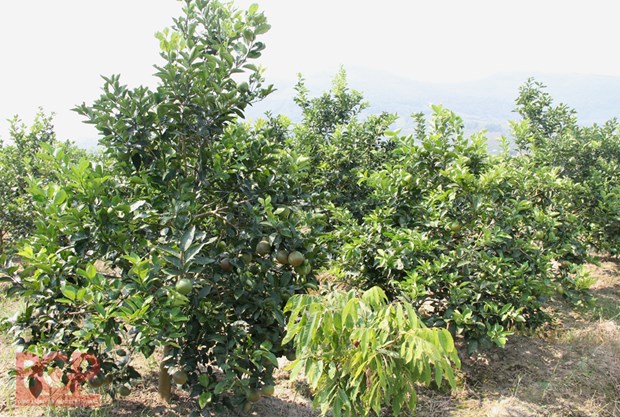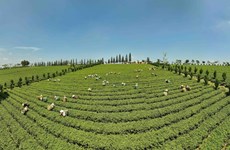Bac Giang farmers cash in on citrus fruit plantation
Citrus farmers in the northern province of Bac Giang have been earning high incomes from growing oranges and grapefruit.
 Luc Ngan develops citrus fruit into VietGAP and GlobalGAP standards. (Photo: bacgiang.gov.vn)
Luc Ngan develops citrus fruit into VietGAP and GlobalGAP standards. (Photo: bacgiang.gov.vn)Bac Giang (VNA) – Citrus farmers in the northern province of Bac Giang have been earning high incomes from growing oranges and grapefruit.
They started growing citrus fruit in Luc Ngan district around ten years ago, and they have since become a local staple and won favour among the pickiest consumers nationwide. In recent years, the district has continued to expand its plantations and followed VietGap standards with the aim of exporting their products.
Tran Thi Phin, a farmer in Truong Sinh village, Tan Quang commune, said her family cultivates Dien grapefruit and green-skin grapefruit on an area of 7,200 square metres, and pockets 300-400 million VND (12,900–17,200 USD) each year.
Since 2017, the orchards have been developed in line with VietGAP standards, with processes such as fertiliser and pesticide use recorded daily, she added.
In a bid to facilitate the sharing of farming techniques to boost growth and consumption, households in Tan Quang commune formed the Luc Ngan fruit production cooperative two years ago. To date, some 50 hectares of oranges and grapefruit have been developed by 22 members under VietGAP standards. Around 20 hectares of oranges received the VietGAP certificate in 2018.
Chairman and Director of the cooperative Tran Dang Vinh said the cooperative plans to increase the acreage of its VietGAP plantations so that their fruits can hit the shelves at domestic and foreign supermarkets. Therefore, all members of the cooperative strictly adhere to clean production requirements.
Realising its efficiency, many households in Thanh Hai, Quy Son and Dong Coc communes have expanded cultivation of in line with VietGAP standards.
According to the district People’s Committee, there are around 6,700 hectares of citrus fruit in the district, which yield an estimated 58,000 tonnes in 2019, up 5,000 tonnes from the previous year. The district is working towards sustainable development by implementing a wide range of measures, including studying and zoning off plantations as well as recommending local farmers not to expand orchards to areas with low potential.
Thanks to the district’s drastic efforts, the acreage of citrus fruits grown in accordance with VietGAP and GlobalGAP stands has increased significantly to 1,800 hectares this year, up by 500 hectares from 2018.
However, several varieties like sweet orange and yellow-fleshed orange are not qualified for export, so Luc Ngan district is building a model to pilot the cultivation of new varieties such as BH and CT 36 in an area covering 15 hectares.
Vice Chairman of Luc Ngan district’s People’s Committee Cao Van Hoan said the district wants all local citrus fruit orchards to follow clean production standards. Besides, it is building a geographical indicator for Luc Ngan’s oranges and pomelo.
Local staples will only win over consumers when they meet all the requirements for food safety and hygiene as well as origin traceability, he said, adding market expansion will be the following step.
In recent years, Luc Ngan citrus fruits have been sold in China and several Southeast Asian countries, however, exports remain unstable, he said.
In a bid to help local famers branch out into new markets for their fruit, Luc Ngan district regularly organizes citrus fruit fairs to promote high-quality staples to consumers. Besides, connections have been forged among state-owned agencies, farmers, scientists and companies to facilitate fruit production, processing and consumption.
This year, the Luc Ngan fruit fair was held from November 29 to December 1./.












